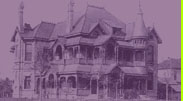LANDMARKS - Civic and Cultural Landmarks
Only a few of the oldest civic and cultural buildings exist today.
Albert Thomas Convention and Exhibition Center - Renovated now Bayou Place
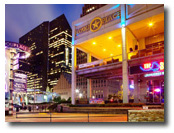 Named for the long-time Houston Congressman, the Albert Thomas Convention and Exhibition Center had 127,500 square feet of exhibition space, 40,000 square feet of meeting rooms and parking for 2,000 cars. It served as a complete, flexible meeting place for the nation's business leaders, as well as a magnificent showplace for the products of various industries. It was also the home of the National Space Hall of Fame. The Albert Thomas convention center became known as Bayou Place on December 31, 1997.
Named for the long-time Houston Congressman, the Albert Thomas Convention and Exhibition Center had 127,500 square feet of exhibition space, 40,000 square feet of meeting rooms and parking for 2,000 cars. It served as a complete, flexible meeting place for the nation's business leaders, as well as a magnificent showplace for the products of various industries. It was also the home of the National Space Hall of Fame. The Albert Thomas convention center became known as Bayou Place on December 31, 1997.
Julia Ideson Library Building
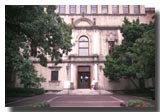 The Julia Ideson Library Building, named for the long-time Houston librarian, was erected in 1926 as part of the planned civic center. It is the only building of a proposed complex that was erected. Designed by Cram & Ferguson, the Ideson Building has been constructed in Spanish Renaissance style. The historical room of the building houses collections of Texas history and the Circle M Collection, donated by Salvation Army Major E. T. Milsaps. Adjoining the Ideson Building is the octagonal shaped new Houston Public Library, completed in 1976. The Library contains over three and one half million books and documents. It is linked to the Ideson Building by a pedestrian tunnel.
The Julia Ideson Library Building, named for the long-time Houston librarian, was erected in 1926 as part of the planned civic center. It is the only building of a proposed complex that was erected. Designed by Cram & Ferguson, the Ideson Building has been constructed in Spanish Renaissance style. The historical room of the building houses collections of Texas history and the Circle M Collection, donated by Salvation Army Major E. T. Milsaps. Adjoining the Ideson Building is the octagonal shaped new Houston Public Library, completed in 1976. The Library contains over three and one half million books and documents. It is linked to the Ideson Building by a pedestrian tunnel.
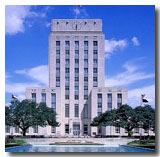 Houston City Hall
Houston City Hall
Next to the public library stand Houston City Hall. Completed in 1939, the structure was designed by Joseph Finger and built by the Public Works Administration using white fossilized limestone. The ceiling murals were painted by Daniel MacMorris and depict the themes of industry, law, culture and administration.
Jesse H. Jones Hall for the Performing Arts
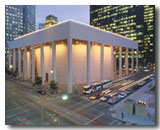 Included in the complex are the Jesse H. Jones Hall for the Performing Arts, the old Sam Houston Coliseum (demolished) , the old Music Hall (demolished) and the old Albert Thomas Convention Center (demolished). Jesse Jones Hall, which opened in 1966, stands on the site of the old Houston Auditorium. The Houston Endowment, Inc., a charitable fund set up by Jesse Jones himself, provided the funds for erecting the hall, with a seating capacity of up to 3,000, in memory of Jesse Jones' life of service to the nation and to the city. In the lobby of Jones hall is a sculpture by Richard Lippold. Called Gemeni II, it is an artistic rendition of the spirit of the Space Age made of 2,300 polished aluminum rods held in place by 90,000 feet of gold plated wire, creating an illusion of shimmering rays in space flight. The elegant teak-wood paneling of Jones Hall achieves the ultimate in theater-concert hall design.
Included in the complex are the Jesse H. Jones Hall for the Performing Arts, the old Sam Houston Coliseum (demolished) , the old Music Hall (demolished) and the old Albert Thomas Convention Center (demolished). Jesse Jones Hall, which opened in 1966, stands on the site of the old Houston Auditorium. The Houston Endowment, Inc., a charitable fund set up by Jesse Jones himself, provided the funds for erecting the hall, with a seating capacity of up to 3,000, in memory of Jesse Jones' life of service to the nation and to the city. In the lobby of Jones hall is a sculpture by Richard Lippold. Called Gemeni II, it is an artistic rendition of the spirit of the Space Age made of 2,300 polished aluminum rods held in place by 90,000 feet of gold plated wire, creating an illusion of shimmering rays in space flight. The elegant teak-wood paneling of Jones Hall achieves the ultimate in theater-concert hall design.
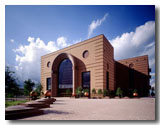 Wortham Theater Center
Wortham Theater Center
The Wortham Theater Center is a performing arts center in Houston, Texas, United States. The Center was designed by Eugene Aubrey of Morris Architects and built entirely with $66 million in private funds. It officially opened on May 9, 1987 with one of the inaugural performances being a modern dance program, Tango Argentino, in the Brown Theater and Robert Wilson and David Byrne's The Knee Plays, presented by the Society for the Performing Arts in the Cullen Theater.
Alley Theatre
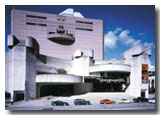 Opposite Jones Hall stands the Nina Vance Alley Theatre, built in 1969. It is the home of the repertory theater founded and directed by the late Nina Vance. One of the finest residential professional theatres in the U.S., the Alley features an 800-seat multi-space stage and a 300-seat arena.
Opposite Jones Hall stands the Nina Vance Alley Theatre, built in 1969. It is the home of the repertory theater founded and directed by the late Nina Vance. One of the finest residential professional theatres in the U.S., the Alley features an 800-seat multi-space stage and a 300-seat arena.
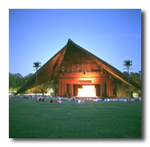 Miller Outdoor Theater
Miller Outdoor Theater
Miller Outdoor Theater in Hermann Park, recently renovated, is an open-air theater which features professional and amateur productions.
Houston Museum of Natural Science
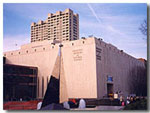 The Houston Museum of Natural Science, in Hermann Park, contains numerous exhibits, including the Milsaps collection of coins and the Westheimer group of minerals. The Burke Baker Planetarium, opened in 1964, is a unit of the museum.
The Houston Museum of Natural Science, in Hermann Park, contains numerous exhibits, including the Milsaps collection of coins and the Westheimer group of minerals. The Burke Baker Planetarium, opened in 1964, is a unit of the museum.
Museum of Fine Arts
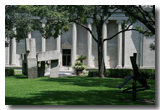 The Museum of Fine Arts, designed by William Ward Watkin, was completed in 1924 and features a wide range of exhibits including the Beck collection of French impressionists; Venetto's Portrait of a Man; Tintoretto's baroque exercise, Tancred Baptising Clorinda, painted around 1852; and Umlauf's The Fishers and The Pieta.
The Museum of Fine Arts, designed by William Ward Watkin, was completed in 1924 and features a wide range of exhibits including the Beck collection of French impressionists; Venetto's Portrait of a Man; Tintoretto's baroque exercise, Tancred Baptising Clorinda, painted around 1852; and Umlauf's The Fishers and The Pieta.
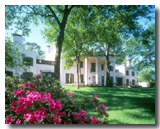 Bayou Bend
Bayou Bend
Bayou Bend, the home of the Hogg family at 2940 Lazy Lane, was donated by Miss Ima Hogg to the Museum of Fine Arts in 1966. It houses Miss Hogg's collection of seventeenth to nineteenth century decorative arts and period rooms.
Rothko Chapel
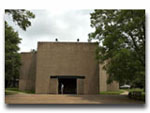 Named for the late painter Mark Rothko, the Rothko Chapel is a small octagonal building commissioned by the de Menil family as an ecumenical chapel. Fourteen huge abstract canvasses by Rothko hang in the chapel, illuminated by a single skylight. The resulting effect is subdued and mysterious. Outside the chapel stands Barnett Newman's sculpture, the Broken Obelisk, also commissioned by the de Menils.
Named for the late painter Mark Rothko, the Rothko Chapel is a small octagonal building commissioned by the de Menil family as an ecumenical chapel. Fourteen huge abstract canvasses by Rothko hang in the chapel, illuminated by a single skylight. The resulting effect is subdued and mysterious. Outside the chapel stands Barnett Newman's sculpture, the Broken Obelisk, also commissioned by the de Menils.
Other Theaters 0utside the Downtown Business District
River Oaks Theatre
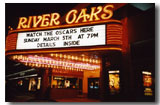 The River Oaks Theatre was built in 1939. It is an example of late-1930s Art Deco design. It was the last of the deluxe neighborhood movie theaters built by Interstate Theatre Corporation. Since 1976, the theater has been operated by Landmark Theatres and generally shows foreign language and independent films, as well as other "art-house" movies. In 1986, Landmark split the spacious balcony in two, turning the theater into a three-screen facility. The theater is a part of the River Oaks Shopping Center, located on the eastern edge of the prestigious River Oaks subdivision. The property and River Oaks Theatre have been well maintained and they still shine today.
The River Oaks Theatre was built in 1939. It is an example of late-1930s Art Deco design. It was the last of the deluxe neighborhood movie theaters built by Interstate Theatre Corporation. Since 1976, the theater has been operated by Landmark Theatres and generally shows foreign language and independent films, as well as other "art-house" movies. In 1986, Landmark split the spacious balcony in two, turning the theater into a three-screen facility. The theater is a part of the River Oaks Shopping Center, located on the eastern edge of the prestigious River Oaks subdivision. The property and River Oaks Theatre have been well maintained and they still shine today.
Alabama Theatre
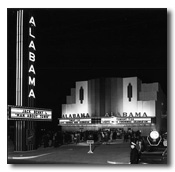 The Alabama was a historic movie theater located at the intersection of Alabama Street and Shepherd Drive in the Upper Kirby district of Houston. Constructed back in 1939, in the Art Deco and Streamline Moderne styles of a suburban theater, the Alabama primarily booked roadshow engagements through most of its history. After the Alabama stopped showing movies in 1983 the building reopened the following year as a Bookstop after a restoration and adaptation designed by Judith Urrutia and Billy Lawrence of San Antonio. Bookstop closed in 2009 after owners Barnes & Noble moved to a new store built on the site of the River Oaks Shopping Center. Unfortunately, Weingarten Realty Investors, the property owner, removed the screen wall and the trademark auditorium murals in 2011 during their recent work designed to attract a new tenant to the vacant space. Trader Joes recently purchased this landmark location for their new store in Houston.
The Alabama was a historic movie theater located at the intersection of Alabama Street and Shepherd Drive in the Upper Kirby district of Houston. Constructed back in 1939, in the Art Deco and Streamline Moderne styles of a suburban theater, the Alabama primarily booked roadshow engagements through most of its history. After the Alabama stopped showing movies in 1983 the building reopened the following year as a Bookstop after a restoration and adaptation designed by Judith Urrutia and Billy Lawrence of San Antonio. Bookstop closed in 2009 after owners Barnes & Noble moved to a new store built on the site of the River Oaks Shopping Center. Unfortunately, Weingarten Realty Investors, the property owner, removed the screen wall and the trademark auditorium murals in 2011 during their recent work designed to attract a new tenant to the vacant space. Trader Joes recently purchased this landmark location for their new store in Houston.
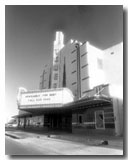 Tower Theater (Renovated into Restaurant)
Tower Theater (Renovated into Restaurant)
The Tower Theater's grand opening was on Valentine's Day 1936 and was converted later to a live theater in 1979. It opened its doors with the stage performance of the Texas based play The Best Little Whorehouse in Texas, which achieved national acclaim on Broadway. The theater's original interior was later remodeled, but its façade was rehabilitated in 2010 after the marquee was damaged in Hurricane Ike. A Tex-Mex restaurant now occupies the old auditorium space.
Lost Cultural and Civic Landmarks
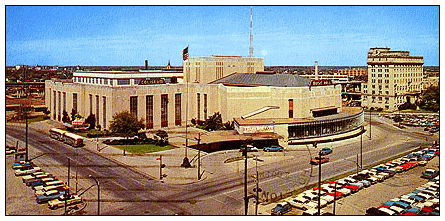
The Sam Houston Coliseum and Music Hall (Demolished)
Sam Houston Coliseum was an indoor arena, located in Houston, Texas. It was located at 801 Bagby Street near downtown. The arena was opened in November 1937 and had a capacity of 9,200. It was built in conjunction with the Houston Music Hall, which was adjacent to the Coliseum.
The Coliseum and Music Hall complex replaced the Sam Houston Hall, which was a wooden structure that had been erected on the site for the 1928 Democratic National Convention and torn down in 1936. In 1946, permanent ice chillers were installed in the floor to accommodate an ice hockey rink for Houston's first pro ice hockey team - the Houston Skippers of the USHL. The Skippers changed their name the following season to the Houston Huskies and called the Coliseum home until their demise in 1949. Prior to Hofheinz Pavilion being built, the Houston Cougars played select home games at the coliseum.
The venue also played host to the Houston Apollos, of the CPHL, from 1965-1969, Houston Mavericks, of the American Basketball Association, from 1967-1969, the Houston Aeros, of the WHA, from 1972-1975 and the Houston Apollos, of the CHL, from 1979-1981. The Aeros moved to The Houston Summit, which opened in November 1975 and played their final 4 seasons there. The Houston Mavericks, of the ABA, played their home games from 1967-1969. The First National Women's Conference, a milestone for the modern women's movement, was held at the Coliseum in November, 1977.
On October 14, 1956, Elvis Presley's concert at the Coliseum ended abruptly, as he and his band were taken away by police escort, just before the end of the show as a mob of about 1,000 teenagers rushed the stage, their instruments being destroyed as a result. On August 19, 1965, The Beatles performed at the Coliseum. Jimi Hendrix played there on June 6, 1970, three months before he died. The Black Crowes played a free concert at the venue in 1993. The free show was due to security problems that forced the cancellation of the last show they played in Houston. The show was broadcast nationally on radio across North America and also was videotaped for the video "Bad Luck Blue Eyes Goodbye." The audio version was released on EPs, dubbed "High in Houston."
The Coliseum was also home to Houston Wrestling, run by legendary wrestling promoter, Paul Boesch. Jack Brisco defeated Harley Race to win the National Wrestling Alliance (NWA) world heavyweight professional wrestling championship at the Coliseum on July 20, 1973. It was an event promoted by Boesch. Sam Houston Coliseum was demolished in 1998. The former site of the Sam Houston Coliseum was redeveloped into the Hobby Center for the Performing Arts, which opened its doors in 2003.
Oscar F. Holcombe Civic Center (Demolished)
Within a short walking distance, in the heart of downtown, was the Oscar F. Holcombe Civic Center, the site of trade shows, sporting events, operas, ballets, conventions and other events. A $40 million complex of four magnificent exhibition buildings, the Civic Center was close to major hotels, theaters, specialty shops, department stores, restaurants, clubs and office buildings.



